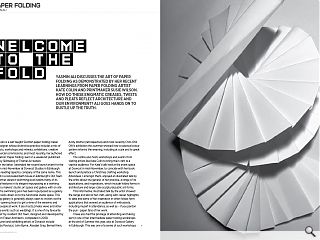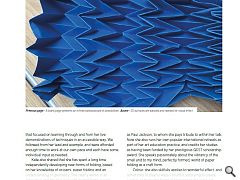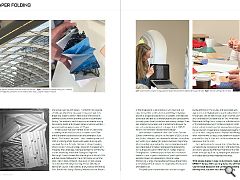Paper Folding: Into the Fold
27 Jan 2025
Yasmin Ali discusses the art of paper folding as demonstrated by her recent learnings from paper folding artist Kate Colin and printmaker Susie Wilson. How do these enigmatic creases, twists and pleats reflect architecture and our environment? Ali goes hands-on to rustle up the truth.
Kate Colin is a self-taught Scottish paper folding maker and designer whose distinctive practice includes a mix of products, workshops and retreats, exhibitions, creative commercial commissions, and most recently, her authored publication ‘Paper folding: learn in a weekend’ published 2024 by Skittledog of Thames & Hudson. For the latter, I attended her recent launch event for the book in mid-November at Dovecot Studios in Edinburgh for the leading tapestry company of the same name. This is sited in a renovated bath house in Edinburgh’s Old Town.
This former derelict swimming pool retains many of its original features in its elegant repurposing as a working tapestry makers’ studio, art space and gallery with on site café. The swimming pool has been repurposed as a gallery which looks down on to the functional studio space. This viewing gallery is generally always open to visitors via the public opening hours to get a view of the weavers and craftspeople at work. It also hosts private views and other private events such as weddings. It is one of my favourite gems of my resident Old Town, designed and developed by Malcolm Fraser Architects, completed in 2008. Alumni and exhibiting artists of Dovecot include Eduardo Paolozzi, John Byrne, Alasdair Gray, Bernat Klein, Andy Warhol (retrospective) and most recently Chris Ofili. Ofili’s exhibition this summer showed how a selected colour pattern informs the weaving, including at scale and to great effect.
The centre also hosts workshops and events from visiting artists like Kate Colin to bring their craft to a captive audience. For Kate’s talk held at the event space at Dovecot in mid-November, to coincide with her book launch and preface a Christmas crafting workshop. Attendees, I amongst them, enjoyed an illustrated talk by the artist about the genesis of her practice, a range of its applications, and inspirations, which include folded forms in architecture and large scale sculptural public art forms. This informative, illustrated talk by the artist showed the range and skill of her craft, along with career highlights to date and some of her inspiration in other folded form applications that wowed an audience of enthusiasts, including myself in attendance, as well as – if you pardon the pun - paper fans of her work. I have also had the privilege of attending and taking part in one of her intermediate paper folding workshops at the end of Summer this year, also at Dovecot Gallery in Edinburgh.
This was one of a series of such workshops that focused on learning through and from her live demonstrations of techniques in an accessible way. We followed from her lead and example, and were afforded enough time to work at our own pace and each have some individual input as needed. Kate also shared that she has spent a long time independently developing new forms of folding, based on her knowledge of origami, paper folding and an understanding of geometry. She clearly works in an innovative and intuitive way with folded forms, fusing inspiration and structural insights of working with paper and its skilled formation into geometric three-dimensional constructions. These structures themselves have an elegance and structural integrity, as well as sculptural qualities including aesthetic. Symmetry and harmony are clearly important in her composition and form part of a rationale for invention of new forms. She has elevated the art of folding paper to create her craft, in a considered way. She has learned from others in esteemed international renown in this niche, such as Paul Jackson, to whom she pays tribute to within her talk.
Now she also runs her own popular international retreats as part of her art education practice, and credits her studies as having been funded by her prestigious QEST scholarship award. She speaks passionately about the vibrancy of the small and to my mind, perfectly formed, world of paper folding as a craft form. Colour, she also skilfully applies to wonderful effect, and sometimes in playful ways. I found it satisfying to create a series of maquette forms in response to the tasks set, all in the same colour and weight of paper to focus on its form and formation as part of my learning. Pleasingly, as pictured, the shoebox I brought along in my preparedness was a near exact colour match to the shade of paper. As pictured, I chose to confine my colour palette to focus on form. Kate Colin has been able to adapt and redesign and reform new configurations of folded forms using her knowledge of how the paper responds to folds and retains its structural integrity, sometimes even becoming springy and tensile, such as with spirals. The rhythm and spacing of folds can affect how the paper moves and retains its shape and is able to stretch. Nearly all of the forms are symmetrical and involve uniform spacing in scoring and folding.
Our arsenal in her folding class included a scoring tool, a bone folder and coloured paper of varying weights – we used medium weight paper of 120gsm. Folding paper has been familiar to me for a long time in creating artists’ books in various courses, since 2014, with Edinburgh-based book artist and printmaker Susie Wilson. For the past two years, I have revived my love and craft of creating artists’ books with Susie’s tutoring with one week Summer Schools. I revived my love of creating artists’ books in 2023 at Bridge House Art in Ullapool with ‘Mapping The Landscape’, having attended her community course inspired by nature that Spring in Craigmillar, Edinburgh. I later followed this attending Leith School of Art with her course ‘Nature and The Artist’s Book’ in Summer 2024. Also in 2024, in March, I was lucky to gain a place on Susie’s four Saturdays morning classes with City of Edinburgh Council in its Central Library, funded with money from The British Library’s Fantasy festival subtitled ‘Realms of the Imagination’. Each ambitious two-hour sold-out class worked with a full cohort around fifteen interested people of all ages and abilities, to a complex brief that was achievable and able to be interpreted by each participating uniquely, given Susie’s skilled and welcoming tutelage. Susie has inspired, encouraged and enabled me to develop my own arts education practice for all ages, first in 2013-15, which I then revived in and beyond lockdown. With renewed confidence fresh from Susie’s Summer School a few months’ prior, in the first term of 2024, after a long hiatus, I designed and delivered a sell-out course of my own with City of Edinburgh’s Adult Education Programme, which is widely regarded as the most comprehensive and well-organised affordable lifelong learning programme run by the public sector within the UK.
Called ‘Creative Cartographies’, I used the physical form and conceptual nature of maps to give a theme to unify each participant’s personal project as a response to this brief, while introducing a range of accessible techniques that employ printmaking without a press, thus replicable at home and affordable to all. The participants were enthusiastic and encouraged by the ambition of my course, and responded with aspirations that I helped each student realise within their final project. We are still in touch, as an informal collective, and I arranged an Outreach tour to ‘The Printmaker’s Art: Rembrandt to Rego’ as our class trip, with the kind support of the National Galleries of Scotland Learning Centre. The outputs of my students really impressed me and gave me the satisfaction of seeing how inspired and creative they could be, and I bring my skills in Playwork and Pedagogy when working with all ages, encouraging my students to play and this playful response can be intuitive and work to silence our internal critic. I am really excited to re-examine my key themes of cartography by incorporating Kate’s folding techniques, and also to elevate my making of hand bound artists’ books, as taught by Susie, by adapting her key forms, and re-incorporating printed materials into these.
With sincere thanks to Kate Colin, Dovecot, Susie Wilson, UPRIGHT Gallery, NGS Learning Team, City of Edinburgh Council Adult Education and Community Learning and Development, Libraries and Lifelong Learning.
|
|





